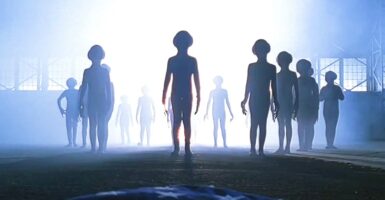The Disney Fan-Favorite That Changed Because Of Terrorism

Despite the common refrain that Americans should “never forget” the tragic events of September 11, 2001, there are a number of pieces of media that have been scrubbed from the public eye due to accidental references to the terrorist act. One shining example of this phenomenon can be found, surprisingly, in the 2002 family comedy Lilo & Stitch, which originally boasted a much different ending than the one that can be seen today. The original ending of the Disney film centered on the title character, Stitch, hijacking a passenger airplane and flying it through a bustling city, grazing buildings as it careened wildly through the sky.
Lilo & Stitch was not the only piece of art that was majorly impacted by the tragic events of 9/11, as many films, albums, and other pieces of media were forced to scrub references to the World Trade Center.
Obviously, the imagery of a hijacked plane smashing buildings would be highly inappropriate and traumatic for general audiences to witness so soon after the 9/11 attacks, prompting Lilo & Stitch animators to scramble to redo the entire climactic sequence. Instead, the assets used to animate the sequence were reworked, swapping the airplane for an alien spacecraft and a downtown cityscape for the tropical beaches of Hawaii. Needless to say, the original animation was completed far in advance of the actual 9/11 hijackings, and the Disney team had no idea that the footage would retroactively become so unnerving following the real-life event.

Still, the film ultimately benefitted from the change, as a majority of the narrative takes place in a semi-remote beach locale, making the busy downtown section of Honolulu a poor choice of setting to bolster the final act. Videos of the original Lilo & Stitch ending have surfaced online in the decades since the film’s release, with some media outlets even rendering a side-by-side comparison of the original version and the theatrical edition.
Obviously, the imagery of a hijacked plane smashing buildings would be highly inappropriate and traumatic for general audiences to witness so soon after the 9/11 attacks, prompting Lilo & Stitch animators to scramble to redo the entire climactic sequence.
Lilo & Stitch was not the only piece of art majorly impacted by the tragic events of 9/11, as many films, albums, and other media were forced to remove references to the World Trade Center. Sam Raimi’s 2002 Spider-Man originally featured scenes and promotional material showcasing the towers, including one advertisement showing the titular wall-crawler hemming up a stolen helicopter between the Twin Towers with his webs.
Still, catching the original Lilo & Stitch ending on YouTube now, over 20 years later, is enough to send chills down the spines of many Americans.
Other examples are quite eerie, such as the 2001 album Party Music by the hip-hop funk band The Coup, which featured an image of the Twin Towers exploding on the album cover. Likewise, legendary comedian George Carlin taped his final comedy special on September 10, 2001, which carried the unfortunate title I Kinda Like It When A Lotta People Die. While projects such as Lilo & Stitch and Party Music were able to be adjusted and released on schedule, Carlin’s final album wouldn’t be delivered to the public until over 15 years later due to the sensitive subject matter discussed during the recording.

Again, all of the above examples were created before the events of 9/11, and all parties involved rapidly scrambled to sensitize their works before releasing them to the public in the wake of the historic event. Still, catching the original Lilo & Stitch ending on YouTube now, over 20 years later, is enough to send chills down the spines of many Americans. 9/11 truly changed everything in American culture, from our art to our airline security and safety standards to the socio-political landscape of the world throughout the 21st century.












